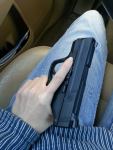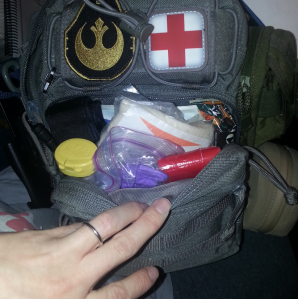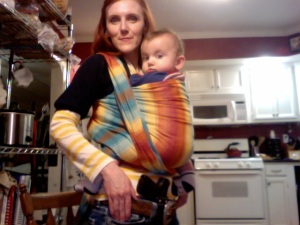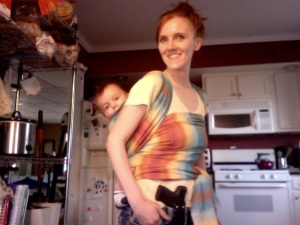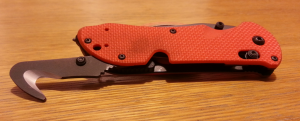This After Action Review (AAR) was originally posted on DefensiveCarry.com on Oct 2, 2007. It was my very first defensive handgun class and I still remember many things about that class. To go back and read this review was a fantastic glimpse into how far I’ve come in the last seven years. I remember the level of stress I felt taking this class and to think back on it makes me almost laugh but also reminds me what new students face and it’s an important reminder not to look critically at people who are taking their first baby steps into a new world. To read the original draft, click here. Enjoy.
Introduction:
When it comes to training someone to defend himself (lethally if need be) there are as many theories, techniques and idea as there are shooters. It can be like math, or it can be like history.
Some training is as simple as two plus two. There are simple rules that need to be applied, such as grip, stance, the draw, and so on. These things are fundamentals that can be built upon and used to solve more complicated problems later on. Other instructors may encourage their students to go about those things a different way but the principle is entirely the same: do what you need to do safely and efficiently so you can save a life.
However, there is also another side to firearms instruction and that is made up of ideas, constructed within laws, facts and other ideas. Who do I choose to protect with my firearm? When is the appropriate time to draw? How do you deal with the police? What should I do after an encounter? One can instruct on these matters within the law, based of personal experience and ideas, but it is up to the individual doing to learning to decide what they will accept and what they will not and what I may glean as true and right may be what another shooter rejects. This is neither a good not a bad thing. It’s evidence that we are individuals with individual minds, beliefs, ideas, and morals that we want to individually adapt and morph. It is up to us to decide what consequences we will accept for those beliefs and ideas.
As evidence to this fact, my husband and I both took the two-day, General Defensive Handgun Class provided by Insights Training Center and if he were to write a review of the class it would probably be a lot different than mine. While the company is based out of Washington State, they travel the country providing more localized training. This particular class was held in Harrisburg, Pennsylvania, and cost 300 U.S. dollars per student.
Day One:
Day one started with introductions of the instructor, Greg Hamilton, and the participants of the class, of which I was the only woman enrolled. After we got through firearms safety we went on to what I like to call the arithmetic of shooting, the basic rules to be built upon to make them an advanced shooter: grip, stance, sight alignment, sight picture, trigger control, follow through and so on. Some instructors may disagree on certain techniques, but the result is the same: kill him before he kills you.
A number of these “basics” were not new concepts for me, but were modified slightly or explained and shown to me the way no one had been able to do so before. What I knew in theory finally became practice.
Finally, the instructor imparted on us poor souls the key to being a successful shooter. The principle is simple, yet profound, and it is that you never miss. You will always hit what you are aiming at, and you’re bullet will always go where it is pointed. The principles of stance, grip, sight alignment and picture and follow-through are all in place to help the shooter aim sure, putting the front sight where needed so that the bullet can follow.
We then learned the priorities of survival:
1) Mindset
2) Tactics
3) Skill
4) Equipment
We’ve all heard, dozens and probably thousands of times that mindset is the most important part of self-defense and I don’t think that anyone would argue that point. The idea is that without the will to live and to fight and to survive, it doesn’t matter if the person has a bazooka in their hands. There are little old grandmas who defeat attacks from much more able-bodied attackers just because they had the mindset that said they would not be victims. Mindset is the first priority.
Second, is tactics. Some tactics can be learned, but some are born out of the necessity of the situation. The people who are unarmed, but have the mindset to survive and to prevail will improvise their tactics to succeed, no matter what is required.
A person can be born with a measure of skill, but usually skill is learned. However, someone does not need to be skilled to survive and that is why it is more important to have mindset and tactics than it is to have skill. The little old grandmother with her bare hands can be just as effective as the skilled, training shooter, as long as she has the will to get going and the idea that sets her will in place. However, skill can help and be built upon and keep you alive longer and healthier than the lack thereof.
It’s also news to no one that a gun is not necessary to defend one’s self. In the absence of a gun anything can be used whether it be a knife, hands and feet, a fork, a chair or a gallon of milk. Those who choose to carry a gun for self-defense are a step up on the equipment scale, but a $3,000 gun will never mindset, tactics or skill, nor should it.
Then we were lectured on the two Principles of Personal Defense
1) Awareness
2) Decisiveness
You can have all the things necessary to survive a confrontation, but if you are unaware of your surroundings or undetermined as to whether you should act, you are as hindered as though you have nothing.
He also talked about expectations in a gunfight, which I found to be very helpful to me. He expressed that it is true that more than likely only a few rounds are necessary to end a fight in a personal defense situation, don’t expect that. My favorite phrase of the day was, “I expect to shoot through the entire magazine in my gun, my entire spare magazine, jump on top of him and beat him with my empty gun and then cut his head off with my knife, because everyone knows the fight isn’t over until his head is not at least three feet from his body.” It was a very unique way of looking at the situation.
Finally, after lunch we got to do some shooting. The first moments on the firing line were as terrorizing, as they were stressful, intense, confused and aggravating. Our instructor had said stress management was a key to being a good defensive shooter and that one of the ways to ensure you do not act prematurely under stress is to make sure that your practice is as stressful or worse than the real thing. He had told us he was going to make our practice stressful and he was right.
He was screaming, there was gunfire, brass was flying, the brain was going a million miles an hour trying to remember everything he just said, he was behind you, screaming, and you’re trying to act, all at the same time. Luckily there were no dropped guns, but there was a lot of cursing and startled faces. The worst part of the first few moments on the firing line was the fact that we weren’t doing very much. We weren’t drawing, we were moving, we weren’t doing anything but extending our firearms from the ready position, finding our sights, pressing the trigger and tactical reloads. Looking back I’m sure there’s not a one of us who doesn’t feel silly for how panicked we all felt in those first couple of minutes, but it was a stepping-stone to greater things.
Finally, we did get to doing some drawing, then more work on sight alignment, and we went back in for more lecture on the difference between justifiable and criminal force before we all went home to prepare for the next day.
Day Two:
On a personal note, I was sicker than a dog for the start of day two. We assembled in the classroom but started our day immediately on the range. I was sick enough to have to run to the bathroom a couple times, but determined to go on despite the pain in my gut, the nausea, and chills, and the desire to curl up in the fetal position and die. Amazingly enough, that morning while doing accuracy drills, I kicked everyone’s butt, but hardly cared at the moment. I wanted a painkiller and a bed.
From accuracy drills we moved right on to firing from the ready position, drawing and firing and rapid firing. After which we went inside for more lecture.
I sat at the table curled into a ball, clutching poor JD’s leg, trying to distract myself from the agony I was feeling in those moments but still listening intently.
Now we went into the Defensive Condition Color Codes of Awareness:
White (Unaware)
Yellow (Relaxed Alert)
Orange (Specific Alert)
Red (Fight Imminent)
Black (Fight Confirmed)
“Triggers” (Situationally Dependent)
Then we also went into the ready positions for the Color Codes of Awareness.
We also discussed guns, holsters, and other useful equipment like OC spray, flashlights, cell phones, knives and in what situation we might decide to use one over the other and how those tools can be used as deterrents so that one may never have to escalate to using a gun.
It was lunch before we went out to do more shooting and I was starting to feel a little better, so I did order a sandwich, only to regret eating it later.
I was again, in agony, while we did “identifying the target” drills.
We went back into class to discuss ballistics, gunshot wounds, shooting through the pain (which was a very appropriate lecture for me at that moment) and the aftermath of a shooting—everything from psychological, physical and legal.
We also discussed a little bit more about expectations and where to fire and to keep firing until the threat was down. And even then we should still be reloading and preparing ourselves for more while searching for secondary targets. He also warned us never to get into the idea that just because a threat is running away or on the ground the fight is over. One can still be running away and firing, or just running to cover to return more fire. He can still be on the ground with a gun. One should fire until the threat has stopped doing whatever he was doing to start it all in the first place.
When we went back out again, we did speed reloads and clearance drills. Loading up our magazines with snap caps and live ammo and going to town while still identifying out targets, drawing, firing, following up and scanning the area.
By the time we moved on to practicing the three zones of fire—the chest, head and pelvis—I was finally starting to feel like a human being again. My energy and good nature was returning and I wasn’t feeling so ill. It was a good thing too, because now we moved on to moving and shooting while doing everything we’d mentioned before. Finally, we added in communication to the mix: screaming commands to the attacker and to by-standers both before, during and after the shooting, to make sure everyone knows what’s happening and what to do next.
During that string of fire I saw a piece of brass enter my field of vision just before it clocked me a good one on the nose, bounced and hit my glasses and then left my field of vision as I kept shooting. My nose was stinging like crazy but I didn’t stop. I felt something sticky after the firing was over, turned to the instructor and asked if I was bleeding and he said I was. I now have a nice cut on the top of my nose from a piece of angrily wielded brass from the .40 caliber next to me (at least that’s where I assume it came from). I was not having a good day as far as my health was concerned.
We pretty much ended the class on that note and all went away with smiles on our faces.
When the instructor asked us if we all felt we learned something, everyone was nodding and telling their stories of what they learned. Because I was still feeling poorly and not very talkative, I was keeping to myself when he pointed at me and said, “I know you learned something.”
I was a little shocked and asked what that was and he said that by the end of the class he could see I had much better control of hands and body and more fluid control over the gun. I took that as a pretty big compliment as our instructor only gave out about six compliments the entire class. It wasn’t that he scolded people; he just spent more time moving people forward than congratulating them on what they did. He made sure to tell us to congratulate ourselves however.
What Did I Learn?
I learned that my expectations were a bit skewed and while they were not incorrect I was looking at them from a different angle.
I learned to put into practice things that I knew were correct in theory but never had anyone to instruct me on.
I learned to get angry and act when threatened (not always lethally, of course) instead of getting afraid and indecisive.
I learned that someone could bleed a LOT before they die and it can be nasty but it’s necessary to continue the fight, even if wounded. If you’re alive enough to realize you’ve been hurt, you’ll probably still be alive when you’ve returned fire and help has arrived. Even death is a lousy excuse for not fighting back.
I learned practices for better situational awareness and ways to manipulate my surroundings, even my attacker, to my advantage.
I’ll probably be figuring out all of the stuff I learned for the rest of my life and I hope I never stop learning from that class. I would strongly recommend it to anyone.

